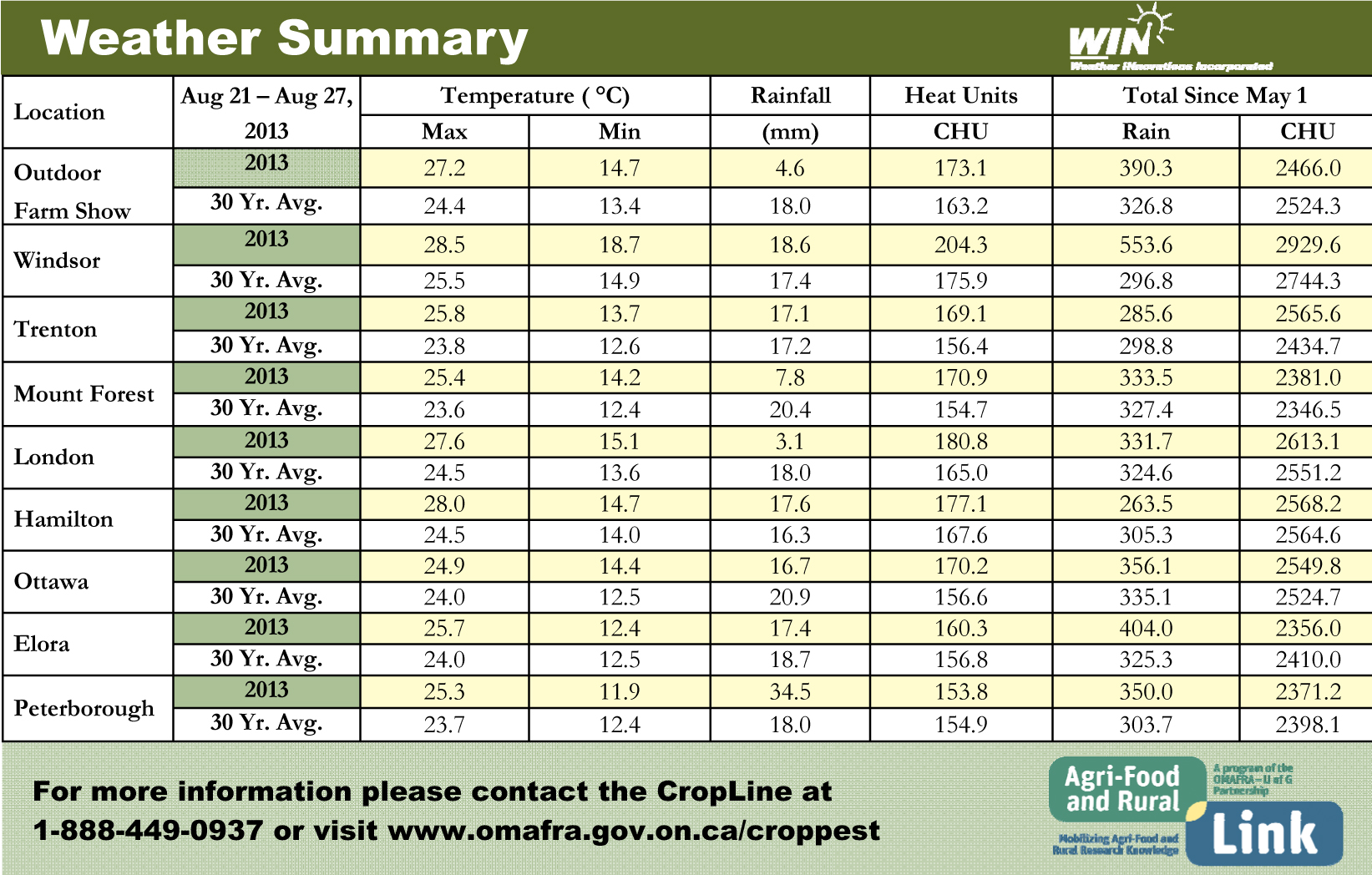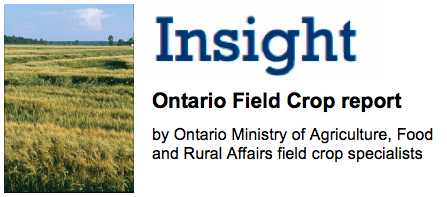Corn: Greg Stewart
The last half of August has provided favourable weather for the corn crop with generally above average CHU accumulation and some needed rainfall in dry areas. However, considerable concern still exists about the maturity of this crop. Normal development for the end of August would be late R4 stage and dented kernels should be showing up at least at the base of the ear. In many areas the crop seems at least a week behind in development. Most of this delay is related to cool night temperatures that significantly slowed the pollination process.
Several times in the past decade warm Septembers have had huge impacts on moving the crop towards maturity, much of this crop will need a favourable September in 2013 as well. Investments in corn dryer upgrades and efficiency improvements might pay dividends this harvest.
Some fields are showing significant N deficiency. This is most likely due to heavy rains that caused denitrification of the N supply and in some cases shallow rooted corn that is not drawing N from deeper levels in the profile. Some firing of lower leaves by the end of August is normal even for crops that have adequate N; firing up to the ear leaf may result in yield reductions.
Forage shortages on some farms is putting pressure on growers to harvest silage sooner than it may be ready. The best silage fermentation and livestock performance usually occurs when whole plant moisture is 65-70%. This corresponds well to horizontal silos, but silage may have to be a bit drier in tower silos to prevent seepage. Recommended moisture contents for corn silage are as follows:
horizontal bunker silos (65-70%)
bag silos (60-68%)
upright concrete stave silos (62-67%)
upright oxygen limiting silo (50-60%)
Cereals: Peter Johnson
Spring cereal harvest is a repeat of winter cereal harvest: northern regions have amazing yields and quality, while production further south fights lower yields and poor quality. New Liskeard region is just beginning harvest, with reports of 2 t/ac oat crops and a 45 lb/bu test weight! Any crops grown without fungicides this year have suffered far more than normal, with low yield, low test weight in oat, and fusarium in barley and spring wheat.
The winter wheat performance trials are available! Go to www.gocereals.ca. New this year are the “managed” trials (Table 1A and 2A), where fungicides are applied. This is a first for performance trials in Ontario, and perhaps in North America. For a better description of how to use the trials to pick a top variety, go to www.fieldcropnews.com and look at the articles “Ramping It Up” and “Picking Top Wheat Genetics."
Cover crop oats have emerged and are growing well where they were planted into moisture. Broadcast seeded and disced in, or shallow seeded crops are poor. Do not forget that nitrogen is required for reasonable fall growth. Apply 50 lbs N/ac to the crop for good forage production.
Edible Beans and Canola: Brian Hall
Canola: Harvest has started with generally good yield and seed quality. Heavy overnight dews are causing increased alternaria (black spot) on pods. Do not delay harvest, because alternaria increases the amount of pod shatter. Some are finding a market for canola straw, especially in the horse market. Ensure crop residue is spread evenly if winter wheat is to be planted no-till. Hair pinning of residue is a significant cause of poor establishment.
In fields with adequate plant population, but uneven in maturity, the typical time of swathing is 60% seed colour change on the main stem. At this stage the seed will contain about 30-35% moisture. Parts of the field will be less than 60% colour change and some more. Seed colour changes about 10% every 2-3 days. Seed colour change is a better indicator than pod or plant colour in when to swath. If you have large acreage to harvest, swathing can begin as early as 40% seed colour change. Swathing before this stage can lower yield and increase the amount of green seed. Green seed content cannot be lowered once canola is stored in the bin.
Edible Beans: Harvest of cranberry beans is underway with average to above average yields and good seed size. Other beans are maturing quickly. Time preharvest applications to pod colour change recommended for the product being used. The majority of pods should have changed colour from light tan to buckskin brown colour. Coloured bean seed should have the desired seed colour change. White bean seed should not be green when the seed is split open. Preharvest herbicides speed up dry down of plants and weeds, but do not hasten seed maturity. Any late maturing areas should be treated or harvested separately. Weather conditions this summer were favourable for anthracnose and bacterial blight. These diseases are seed borne, so seed fields need careful inspection before deciding to retain seed.




